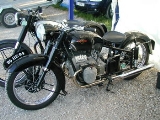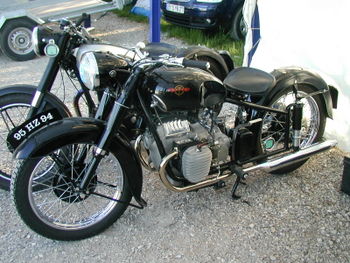
Ratier
Encyclopedia
Ratier-Figeac ia an aircraft
components manufacturer in Montrouge
, France.
From 1926 until 1930 it also built a car
with a 746 cc overhead camshaft
engine
.
From 1959 until 1962 Ratier made motorcycle
s, having taken over the motorcycle business of the Centre d'Études de Moteurs à Explosion et à Combustion (CEMEC
). The engines were flat-twin
s derived from Second World War BMW
designs.
 Ratier was originally a joinery firm at the beginning of the century. By the outbreak of the first world-war, the company specialized in propeller blades for the planes of the French Air Force. Afterwards it produced for the French mail service Aéropostale
Ratier was originally a joinery firm at the beginning of the century. By the outbreak of the first world-war, the company specialized in propeller blades for the planes of the French Air Force. Afterwards it produced for the French mail service Aéropostale
all the way through its heyday of the 1930s when the service broke many flight-records. The factory was originally in Malakoff
and then transferred to Montrouge
. Much of its workload consisted of the contract work it received from Citroën
to produce the Citroenette, a child's pedal-car. Paulin Ratier fabricated a prototype propellor-car which never made it into production.
The company produced a rally-car which went on to win many races, such as the Bol d'or
race, during a time when it was raced by cars and motorcycles. The factory at Figeac produced bicycles during World War II.
After World War II, the company was renamed CEMEC. As a victory spoil, it was the recipient of many motorcycle parts from the German company BMW and the company was able to construct its own motorcycles, sharing many common features with the BMW brand. General Charles de Gaulle
, outfitted his presidential escort with Ratier motorcycles. There were only 1,200 motorcycles produced after the government failed to renew its contract with the company.
Today in Figeac
, the company produces aircraft parts, in particular for Airbus
.
1908 : Paulin Ratier joins with the industrial engineer Bernard Montet to produce the propellors for the Breguet XIV bomber
1914-1918 : War increases demand and production times are tightened. 1917 : Ratier opens a new factory at Figeac in an old saw-mill. Ratier chose Figeac for the abundant wood-supplies in the region, necessary for propellor production.
1919-1929 : After the war, demand falls and Ratier must diversify into other products. Ratier begins to produce toys, electrical appliances and telephones. At the same time, metal propellors come onto the scene and Ratier patents a variable pitch propellor, putting the company among the world's top producers.
1939 : Ratier outfits 90% of the French Air Force, holds 63 world records, 32 foreign licenses, and has branches in Algeria, Switzerland and in Morocco. The company has employs 500 persons.
1941 : Aircraft demand plummets and the company resorts to producing bicycles.
1949-1950 : The company experiences a crisis from lack of demand. The workforce falls below 100.
1951-1961 : Exceptional business opportunities allow the company to diversify and multiply its workforce by 10. G. Forest takes over the company and opens a tool-die factory at Capdenac (today's Forest-Line factory), not far from Figeac.
1961 : Momentum builds in propellor production with Transall and l’Atlantic in particular, and Ratier becomes the flight equipment manufacturer for the Caravelle
1968 : Ratier produces propellors and fan-lift engines.
1970 : Ratier begins working with Airbus to fill orders.
1980 : Ratier produces composite propellors in conjunction with Hamilton Sundstrand and sees its projects multiply with Airbus, Eurocopter, Bombardier, ATR…
1990 : Hamilton Sundstrand brings in new capital to Ratier-Figeac with 20.5% of its parts.
1998 : Hamilton Sundstrand acquires 100% of its capital
2001 : Ratier-Figeac receives the order to produce the elevator for the Airbus A380
2003 : Ratier-Figeac obtains the contract to produce the propellors for the A400M.
2007 : Ratier-Figeac is the only propellor producer for the Hamilton Sundstrand group. It will by entirely incorporated by 2008.
Aircraft
An aircraft is a vehicle that is able to fly by gaining support from the air, or, in general, the atmosphere of a planet. An aircraft counters the force of gravity by using either static lift or by using the dynamic lift of an airfoil, or in a few cases the downward thrust from jet engines.Although...
components manufacturer in Montrouge
Montrouge
Montrouge is a commune in the southern Parisian suburbs, located from the center of Paris, France. It is one of the most densely populated municipalities in Europe...
, France.
From 1926 until 1930 it also built a car
Automobile
An automobile, autocar, motor car or car is a wheeled motor vehicle used for transporting passengers, which also carries its own engine or motor...
with a 746 cc overhead camshaft
Overhead camshaft
Overhead cam valvetrain configurations place the engine camshaft within the cylinder heads, above the combustion chambers, and drive the valves or lifters in a more direct manner compared to overhead valves and pushrods...
engine
Engine
An engine or motor is a machine designed to convert energy into useful mechanical motion. Heat engines, including internal combustion engines and external combustion engines burn a fuel to create heat which is then used to create motion...
.
From 1959 until 1962 Ratier made motorcycle
Motorcycle
A motorcycle is a single-track, two-wheeled motor vehicle. Motorcycles vary considerably depending on the task for which they are designed, such as long distance travel, navigating congested urban traffic, cruising, sport and racing, or off-road conditions.Motorcycles are one of the most...
s, having taken over the motorcycle business of the Centre d'Études de Moteurs à Explosion et à Combustion (CEMEC
CEMEC
The Centre d'études de moteurs à explosion et à combustion ' was a company that continued the construction of BMW motorcycles taken from the German occupying forces after the Second World War. It was founded in 1945 as the Centre de montage et de récupération at Neuilly-sur-Seine...
). The engines were flat-twin
Flat-twin
A flat-twin is a two cylinder internal combustion engine with the cylinders arranged on opposite sides of the crankshaft. It is part of the class of flat engines, sub-type "boxer", and shares most characteristics of those engines.-Motorcycle use:...
s derived from Second World War BMW
BMW motorcycles
BMW's motorcycle history began in 1921 when the company commenced manufacturing engines for other companies. Motorcycle manufacturing now operates under the BMW Motorrad brand...
designs.
History

Aéropostale (aviation)
Aéropostale was a pioneering aviation company. It was founded in 1918 in Toulouse, France, as Société des lignes Latécoère, also known as Lignes Aeriennes Latécoère or simply "The Line" .- History :Aéropostale founder Pierre-Georges Latécoère envisioned an air route connecting France to the...
all the way through its heyday of the 1930s when the service broke many flight-records. The factory was originally in Malakoff
Malakoff
Malakoff is a suburban commune in the Hauts-de-Seine department southwest of Paris, France. It is located from the centre of the city.-History:The commune of Malakoff was created on 8 November 1883 by detaching its territory from the commune of Vanves...
and then transferred to Montrouge
Montrouge
Montrouge is a commune in the southern Parisian suburbs, located from the center of Paris, France. It is one of the most densely populated municipalities in Europe...
. Much of its workload consisted of the contract work it received from Citroën
Citroën
Citroën is a major French automobile manufacturer, part of the PSA Peugeot Citroën group.Founded in 1919 by French industrialist André-Gustave Citroën , Citroën was the first mass-production car company outside the USA and pioneered the modern concept of creating a sales and services network that...
to produce the Citroenette, a child's pedal-car. Paulin Ratier fabricated a prototype propellor-car which never made it into production.
The company produced a rally-car which went on to win many races, such as the Bol d'or
Bol d'or
The Bol d'or is a motorcycle endurance race, held annually in France. Originally, it was an automobile as well as motorcycle race. The automobiles were limited to 1100cc engine capacity until the 1950s when the limit was raised to 1500cc, and later to 2000cc...
race, during a time when it was raced by cars and motorcycles. The factory at Figeac produced bicycles during World War II.
After World War II, the company was renamed CEMEC. As a victory spoil, it was the recipient of many motorcycle parts from the German company BMW and the company was able to construct its own motorcycles, sharing many common features with the BMW brand. General Charles de Gaulle
Charles de Gaulle
Charles André Joseph Marie de Gaulle was a French general and statesman who led the Free French Forces during World War II. He later founded the French Fifth Republic in 1958 and served as its first President from 1959 to 1969....
, outfitted his presidential escort with Ratier motorcycles. There were only 1,200 motorcycles produced after the government failed to renew its contract with the company.
Today in Figeac
Figeac
Figeac is a commune in the Lot department in south-western France.Figeac is a sub-prefecture of the department.-History:Figeac is on the via Podiensis, a major hiking medieval pilgrimage trail which is part of the Way of St. James...
, the company produces aircraft parts, in particular for Airbus
Airbus
Airbus SAS is an aircraft manufacturing subsidiary of EADS, a European aerospace company. Based in Blagnac, France, surburb of Toulouse, and with significant activity across Europe, the company produces around half of the world's jet airliners....
.
Timeline
1904 : Ratier was created by the joiner, Paulin Ratier, in order to fabricate wooden plane-propellors.1908 : Paulin Ratier joins with the industrial engineer Bernard Montet to produce the propellors for the Breguet XIV bomber
1914-1918 : War increases demand and production times are tightened. 1917 : Ratier opens a new factory at Figeac in an old saw-mill. Ratier chose Figeac for the abundant wood-supplies in the region, necessary for propellor production.
1919-1929 : After the war, demand falls and Ratier must diversify into other products. Ratier begins to produce toys, electrical appliances and telephones. At the same time, metal propellors come onto the scene and Ratier patents a variable pitch propellor, putting the company among the world's top producers.
1939 : Ratier outfits 90% of the French Air Force, holds 63 world records, 32 foreign licenses, and has branches in Algeria, Switzerland and in Morocco. The company has employs 500 persons.
1941 : Aircraft demand plummets and the company resorts to producing bicycles.
1949-1950 : The company experiences a crisis from lack of demand. The workforce falls below 100.
1951-1961 : Exceptional business opportunities allow the company to diversify and multiply its workforce by 10. G. Forest takes over the company and opens a tool-die factory at Capdenac (today's Forest-Line factory), not far from Figeac.
1961 : Momentum builds in propellor production with Transall and l’Atlantic in particular, and Ratier becomes the flight equipment manufacturer for the Caravelle
1968 : Ratier produces propellors and fan-lift engines.
1970 : Ratier begins working with Airbus to fill orders.
1980 : Ratier produces composite propellors in conjunction with Hamilton Sundstrand and sees its projects multiply with Airbus, Eurocopter, Bombardier, ATR…
1990 : Hamilton Sundstrand brings in new capital to Ratier-Figeac with 20.5% of its parts.
1998 : Hamilton Sundstrand acquires 100% of its capital
2001 : Ratier-Figeac receives the order to produce the elevator for the Airbus A380
2003 : Ratier-Figeac obtains the contract to produce the propellors for the A400M.
2007 : Ratier-Figeac is the only propellor producer for the Hamilton Sundstrand group. It will by entirely incorporated by 2008.

